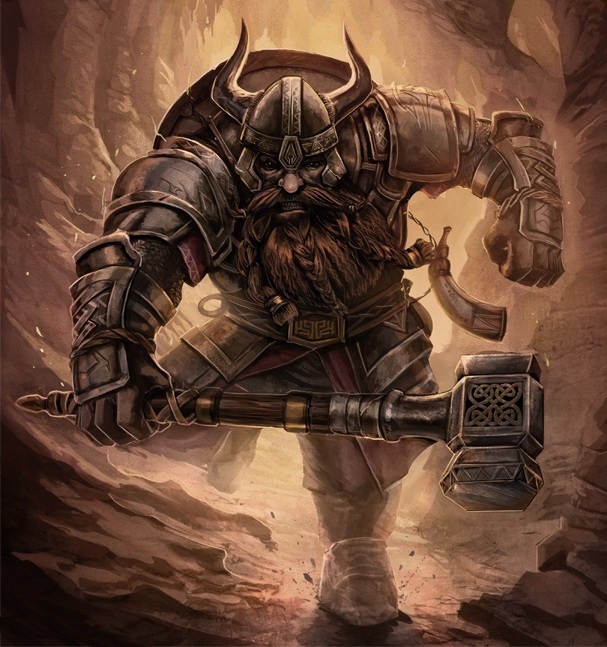Overbearing
Overbearing is a form of melee combat where the combatant aims to physically push or compel an opponent to move back from their defensive position, or combat hex, during battle. The combatant, often with a strong and sturdy posture, lunges or advances toward their opponent with unwavering determination. Their muscles tense as they use their body's mass and strength to execute the maneuver.
The attack can be visualized as a powerful shove or push, where the combatant's weapons and upper body make contact with the defender's body or shield. Designed to disrupt the defender's balance and footing, the attack works best as multiple combatants use this to break an enemy's thinly-held line in a large battle.
| Ratio of attacker to defender | Roll to hit modifier |
|---|---|
| up to 24% | no hit possible |
| 25-32% | -12 |
| 33-41% | -9 |
| 42-58% | -4 |
| 59-71% | -2 |
| 72-87% | -1 |
| 88-116% | none |
| 117-141% | +1 |
| 142-175% | +2 |
| 176-250% | +3 |
| 251-350% | +7 |
| 351% or more | +10 |
Attack Roll
Prior to rolling to hit, the combatant declares and attempt to overbear. The overbearing combatant must use all their action points (AP) to both attack and to move forward one hex, the latter only if the overbearing attack is successful. Attackers with multiple attacks may attempt to overbear as often as they are able; the movement cost is unchanged; however, multiple successful overbearing attacks will drive an opponent back one hex each time the attack is successful.
A d20 is rolled normally, but this does not constitute normal attack. We should imagine two combatants butting against one another while holding weapons and shield, too close to use those weapons as effectively as normal.
Adjustments are made by comparing the attacker's weight to the defender's. For example, if the attacker weighed 40 lbs. and were attempting to overbear a creature weighing 160 lbs., the attacker would have a -12 modifier on their attack die. If the attacker weighed less than 40 lbs., any attempt to overbear would be impossible. Conversely, if the attacker weighed 160 lbs., they would gain a +10 bonus against a 40 lb. defender. The discrepancy is deliberate. In both cases, the whole weight of both attacker and defender are considered, including all the gear they are carrying.
In determining a hit, the defender's armor is not considered, only the defender's dexterity and shield.
Damage
Because weapons and contact still occur, the amount of damage done if the attacker successfully overbears is 1-3, regardless of the weapon used. Bonuses from strength, critical hits, magical weapons and spells continue to apply.
Attackers with multiple attacks cause 1-3 damage each time they successfully hit.
Movement
The image below indicates the movement produced by a successful overbear. Caitlyn forces herself into Dray's hex, pushing him back out of 0518. Were she not successful, no movement would occur. If it should happen that the damage done to Dray caused the latter to be stunned, Dray would not fall back another hex as indicated under those rules. And if Caitlyn were possessed of multiple attacks, she would be able to roll again to overbear, pushing Dray out of hex 0618.
Because of the amount of movement involved, Caitlyn cannot attempt to overbear and attack normally in the same round. A second attack to overbear presumes that the movement out of 0518 and then out of 0618 would all be a single movement over two hexes, not two separate movements. If the second attack were to fail, then the overbearing movement would stop where indicated.
Multiple Defenders
If Dray in the example above were supported by another combatant already standing in 0618, then the weight of that second combatant (Ewan) would be added to Dray's weight to determine Caitlyn's success at overbearing. This is because it's presumed that Dray can use the support of a defender in the second rank in order to hold his position. However, if Ewan were engaged with another attacker, so that he could not commit to supporting Dray's position, then Dray would be pushed into Ewan's hex.
Likewise, if there are multiple defenders in one hex, then Caitlyn would receive a +2 bonus to hit, but she would have to include the weight of all the defenders in that hex with regards to her success at overbearing. However, if the defenders have training to act in tandem in that one hex, she would not receive a +2 bonus. With a successful overbear with two opponents, it's assumed she has cleared the hex, pushing out both defenders.
See Also,
Crashes & Collisions
Charging
Unarmed Combat

